Cleft Lip & Palate
Cleft Lip & Palate Procedures
IF YOU ARE CONSIDERING SURGERY TO CORRECT CLEFT LIP OR PALATE…
In the early weeks of development, long before a child is born, the right and left sides of the lip and the roof of the mouth normally grow together. Occasionally, however, in about one of every 800 babies, those sections don’t quite meet. A child born with a separation in the upper lip is said to have a cleft lip. A similar birth defect in the roof of the mouth, or palate, is called a cleft palate. Since the lip and the palate develop separately, it is possible for a child to have a cleft lip, a cleft palate, or variations of both.
If your child was born with either or both of these conditions, your doctor will probably recommend surgery to repair it. Medical professionals have made great advances in treating children with clefts and can do a lot to help your child lead a normal, healthy, happy life.
This information will give you a basic understanding of the operation, when it can help, how it’s performed, and what results you can expect. It can’t answer all of your questions, since a lot depends on you individual circumstances. Please be sure to ask your surgeon if there is anything you don’t understand about the procedure.
THE IMPORTANCE OF A TEAM APPROACH
Children born with a cleft lip or palate may need the skills of several medical professionals to correct the problems associated with the cleft. In addition to needing plastic surgery to repair the opening, these children may have problems with their feeding and their teeth, their hearing, their speech, and their psychological development as they grow up.
For that reason, parents should seek the help of a Cleft Lip and Palate Team as early as possible. Medical professionals with special experience in the problems of cleft lip and palate have formed such teams all over the country to help parents plan for their child’s care from birth, or even before. Typically, a Cleft Team might include a plastic surgeon, a pediatrician, a dentist, a speech and language specialist, a social worker, a hearing specialist, an ear-nose-throat specialist, a psychologist, a nurse, and a genetic counselor.
Ask your doctor for a referral to a Cleft Team in your area.
ALL SURGERY CARRIES SOME UNCERTAINTY AND RISK
When surgery is done by a qualified plastic surgeon with experience in repairing cleft lip or palate, the results can be quite positive. Nevertheless, as with any operation, there are risks associated with surgery and specific complications associated with this procedure.
In cleft lip surgery, the most common problem is asymmetry, when one side of the mouth and nose does not match the other side. The goal of cleft lip surgery is to close the separation in the first operation. Occasionally, a second operation may be needed.
In cleft palate surgery, the goal is to close the opening in the roof of the mouth so the child can eat and learn to speak properly. Occasionally, poor healing in the palate or poor speech may require a second operation.
PLANNING FOR SURGERY
At your initial consultation, your doctor will discuss the details of the procedure he or she will use, including where the surgery will be performed, the type of anesthesia to be used, possible risks and complications, recovery, costs, and the results you can expect. Your surgeon will also answer any questions you may have about feeding your baby, by breast or by bottle, both before and after the surgery.
In most cases, health insurance policies will cover most or all of the cost of cleft lip or cleft palate surgery. Check your policy to make sure your child is covered and to see if there are any limitations on what types of treatment are covered.
CLEFT LIP SURGERY
A cleft lip can range in severity from a slight notch in the red part of the upper lip to a complete separation of the lip extending into the nose. Clefts can occur on one or both sides of the upper lip. Surgery is generally done when the child is about 10 weeks old.
To repair a cleft lip, the surgeon will make an incision on either side of the cleft from the mouth into the nostril. He or she will then turn the dark pink outer portion of the cleft down and pull the muscle and the skin of the lip together to close the separation. Muscle function and the normal “cupid’s bow” shape of the mouth are restored. The nostril deformity often associated with cleft lip may also be improved at the time of lip repair or in a later surgery.
RECOVERING FROM CLEFT LIP SURGERY
Your child may be restless for awhile after surgery, but your doctor can prescribe medication to relieve any discomfort. Elbow restraints may be necessary for a few weeks to prevent your baby from rubbing the stitched area.
If dressings have been used, they’ll be removed within a day or two, and the stitches will either dissolve or be removed within five days. Your doctor will advise you on how to feed your child during the first few weeks after surgery.
It’s normal for the surgical scar to appear to get bigger and redder for a few weeks after surgery. This will gradually fade, although the scar will never totally disappear. In many children, however, it’s barely noticeable because of the shadows formed by the nose and upper lip.
CLEFT PALATE SURGERY
In some children, a cleft palate may involve only a tiny portion at the back of the roof of the mouth; for others, it can mean a complete separation that extends from front to back. Just as in cleft lip, cleft palate may appear on one or both sides of the upper mouth. However, repairing a cleft palate involves more extensive surgery and is usually done when the child is nine to 18 months old, so the baby is bigger and better able to tolerate surgery.
To repair a cleft palate, the surgeon will make an incision on both sides of the separation, moving tissue from each side of the cleft to the center or midline of the roof of the mouth. This rebuilds the palate, joining muscle together and providing enough length in the palate so the child can eat and learn to speak properly.
RECOVERING FROM CLEFT PALATE SURGERY
For a day or two, your child will probably feel some soreness and pain, which is easily controlled by medication. During this period, your child will not eat or drink as much as usual so an intravenous line will be used to maintain fluid levels. Elbow restraints may be used to prevent your baby from rubbing the repaired area. Your doctor will advise you on how to feed your child during the first few weeks after surgery. It’s crucial that you follow your doctor’s advice on feeding to allow the palate to heal properly.
THE REPAIRED LIP OR PALATE
Children with a cleft palate are particularly prone to ear infections because the cleft can interfere with the function of the middle ear. To permit proper drainage and air circulation, the ear-nose-and-throat surgeon on the Cleft Palate Team may recommend that a small plastic ventilation tube be inserted in the eardrum. This relatively minor operation may be done later or at the time of the cleft repair. In addition, surgery may be recommended by your plastic surgeon when your child is older to refine the shape and function of the lip, nose, gums, and palate.
Perhaps most important, keep in mind that surgery to repair a cleft lip or palate is only the beginning of the process. Family support is critical for your child. Love and understanding will help him or her grow up with a sense of self-esteem that extends beyond the physical defect
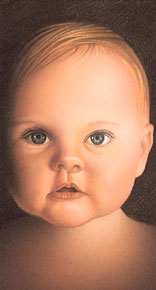
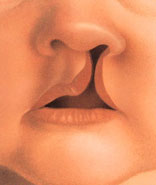
A cleft lip is a separation of the upper lip that can extend into the nose.
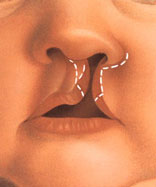
To repair a cleft lip, the surgeon will first make an incision on each side of the cleft from the lip to the nostril.
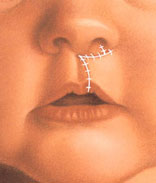
The cleft lip is then drawn together and stitched to create a normal “cupid’s bow” shape to the upper lip.
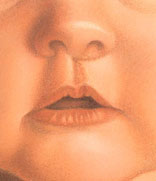
The scar left after surgery will gradually fade with time.
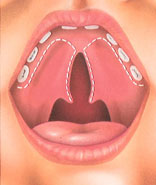
When the roof of the mouth doesn’t grow together properly, the condition is called a cleft palate. To repair it, the surgeon will make an incision along both sides of the cleft.
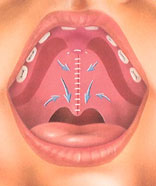
Tissue is drawn together from both sides of the cleft to rebuild the roof of the mouth.
Face
Cleft Lip & Palate Procedures


A cleft lip is a separation of the upper lip that can extend into the nose.

To repair a cleft lip, the surgeon will first make an incision on each side of the cleft from the lip to the nostril.

The cleft lip is then drawn together and stitched to create a normal “cupid’s bow” shape to the upper lip.

The scar left after surgery will gradually fade with time.

When the roof of the mouth doesn’t grow together properly, the condition is called a cleft palate. To repair it, the surgeon will make an incision along both sides of the cleft.

Tissue is drawn together from both sides of the cleft to rebuild the roof of the mouth.
IF YOU ARE CONSIDERING SURGERY TO CORRECT CLEFT LIP OR PALATE…
In the early weeks of development, long before a child is born, the right and left sides of the lip and the roof of the mouth normally grow together. Occasionally, however, in about one of every 800 babies, those sections don’t quite meet. A child born with a separation in the upper lip is said to have a cleft lip. A similar birth defect in the roof of the mouth, or palate, is called a cleft palate. Since the lip and the palate develop separately, it is possible for a child to have a cleft lip, a cleft palate, or variations of both.
If your child was born with either or both of these conditions, your doctor will probably recommend surgery to repair it. Medical professionals have made great advances in treating children with clefts and can do a lot to help your child lead a normal, healthy, happy life.
This information will give you a basic understanding of the operation, when it can help, how it’s performed, and what results you can expect. It can’t answer all of your questions, since a lot depends on you individual circumstances. Please be sure to ask your surgeon if there is anything you don’t understand about the procedure.
THE IMPORTANCE OF A TEAM APPROACH
Children born with a cleft lip or palate may need the skills of several medical professionals to correct the problems associated with the cleft. In addition to needing plastic surgery to repair the opening, these children may have problems with their feeding and their teeth, their hearing, their speech, and their psychological development as they grow up.
For that reason, parents should seek the help of a Cleft Lip and Palate Team as early as possible. Medical professionals with special experience in the problems of cleft lip and palate have formed such teams all over the country to help parents plan for their child’s care from birth, or even before. Typically, a Cleft Team might include a plastic surgeon, a pediatrician, a dentist, a speech and language specialist, a social worker, a hearing specialist, an ear-nose-throat specialist, a psychologist, a nurse, and a genetic counselor.
Ask your doctor for a referral to a Cleft Team in your area.
ALL SURGERY CARRIES SOME UNCERTAINTY AND RISK
When surgery is done by a qualified plastic surgeon with experience in repairing cleft lip or palate, the results can be quite positive. Nevertheless, as with any operation, there are risks associated with surgery and specific complications associated with this procedure.
In cleft lip surgery, the most common problem is asymmetry, when one side of the mouth and nose does not match the other side. The goal of cleft lip surgery is to close the separation in the first operation. Occasionally, a second operation may be needed.
In cleft palate surgery, the goal is to close the opening in the roof of the mouth so the child can eat and learn to speak properly. Occasionally, poor healing in the palate or poor speech may require a second operation.
PLANNING FOR SURGERY
At your initial consultation, your doctor will discuss the details of the procedure he or she will use, including where the surgery will be performed, the type of anesthesia to be used, possible risks and complications, recovery, costs, and the results you can expect. Your surgeon will also answer any questions you may have about feeding your baby, by breast or by bottle, both before and after the surgery.
In most cases, health insurance policies will cover most or all of the cost of cleft lip or cleft palate surgery. Check your policy to make sure your child is covered and to see if there are any limitations on what types of treatment are covered.
CLEFT LIP SURGERY
A cleft lip can range in severity from a slight notch in the red part of the upper lip to a complete separation of the lip extending into the nose. Clefts can occur on one or both sides of the upper lip. Surgery is generally done when the child is about 10 weeks old.
To repair a cleft lip, the surgeon will make an incision on either side of the cleft from the mouth into the nostril. He or she will then turn the dark pink outer portion of the cleft down and pull the muscle and the skin of the lip together to close the separation. Muscle function and the normal “cupid’s bow” shape of the mouth are restored. The nostril deformity often associated with cleft lip may also be improved at the time of lip repair or in a later surgery.
RECOVERING FROM CLEFT LIP SURGERY
Your child may be restless for awhile after surgery, but your doctor can prescribe medication to relieve any discomfort. Elbow restraints may be necessary for a few weeks to prevent your baby from rubbing the stitched area.
If dressings have been used, they’ll be removed within a day or two, and the stitches will either dissolve or be removed within five days. Your doctor will advise you on how to feed your child during the first few weeks after surgery.
It’s normal for the surgical scar to appear to get bigger and redder for a few weeks after surgery. This will gradually fade, although the scar will never totally disappear. In many children, however, it’s barely noticeable because of the shadows formed by the nose and upper lip.
CLEFT PALATE SURGERY
In some children, a cleft palate may involve only a tiny portion at the back of the roof of the mouth; for others, it can mean a complete separation that extends from front to back. Just as in cleft lip, cleft palate may appear on one or both sides of the upper mouth. However, repairing a cleft palate involves more extensive surgery and is usually done when the child is nine to 18 months old, so the baby is bigger and better able to tolerate surgery.
To repair a cleft palate, the surgeon will make an incision on both sides of the separation, moving tissue from each side of the cleft to the center or midline of the roof of the mouth. This rebuilds the palate, joining muscle together and providing enough length in the palate so the child can eat and learn to speak properly.
RECOVERING FROM CLEFT PALATE SURGERY
For a day or two, your child will probably feel some soreness and pain, which is easily controlled by medication. During this period, your child will not eat or drink as much as usual so an intravenous line will be used to maintain fluid levels. Elbow restraints may be used to prevent your baby from rubbing the repaired area. Your doctor will advise you on how to feed your child during the first few weeks after surgery. It’s crucial that you follow your doctor’s advice on feeding to allow the palate to heal properly.
THE REPAIRED LIP OR PALATE
Children with a cleft palate are particularly prone to ear infections because the cleft can interfere with the function of the middle ear. To permit proper drainage and air circulation, the ear-nose-and-throat surgeon on the Cleft Palate Team may recommend that a small plastic ventilation tube be inserted in the eardrum. This relatively minor operation may be done later or at the time of the cleft repair. In addition, surgery may be recommended by your plastic surgeon when your child is older to refine the shape and function of the lip, nose, gums, and palate.
Perhaps most important, keep in mind that surgery to repair a cleft lip or palate is only the beginning of the process. Family support is critical for your child. Love and understanding will help him or her grow up with a sense of self-esteem that extends beyond the physical defect
